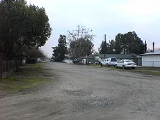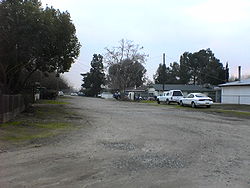
Friant, California
Encyclopedia

Census-designated place
A census-designated place is a concentration of population identified by the United States Census Bureau for statistical purposes. CDPs are delineated for each decennial census as the statistical counterparts of incorporated places such as cities, towns and villages...
(CDP) in Fresno County
Fresno County, California
Fresno County is a county located in the Central Valley of the U.S. state of California, south of Stockton and north of Bakersfield. As of the 2010 census, it is the tenth most populous county in California with a population of 930,450, and the sixth largest in size with an area of . The county...
, California
California
California is a state located on the West Coast of the United States. It is by far the most populous U.S. state, and the third-largest by land area...
, United States
United States
The United States of America is a federal constitutional republic comprising fifty states and a federal district...
. The population was 549 at the 2010 census, down from 778 at the 2000 census. Friant is located 11.5 miles (19 km) north of Clovis
Clovis, California
Clovis is a city in Fresno County, California, United States, northeast of Fresno. The population is estimated to be 97,218 as of September, 2011. Clovis is located northeast of downtown Fresno, at an elevation of 361 feet .-History:...
, at an elevation of 344 feet (105 m).
Geography
Friant is located at 36°59′16"N 119°42′43"W. The CDP is located along the banks of the San Joaquin River and at the base of Friant Dam and Millerton LakeMillerton Lake
Millerton Lake is an artificial lake near the town of Friant about north of downtown Fresno. The reservoir was created by the construction of Friant Dam on the San Joaquin River which with the lake serves as much of the county line between Fresno County to the south and Madera County to the...
.
According to the United States Census Bureau
United States Census Bureau
The United States Census Bureau is the government agency that is responsible for the United States Census. It also gathers other national demographic and economic data...
, the CDP has a total area of 1.3 square miles (3.4 km²), of which 96.2% is land and 3.8% is water.
History
The place was first called Converse Ferry for Charles Converse, who established a ferry across the San Joaquin River in 1852. It was renamed Jones Ferry for J.R. Jones, a local merchant. The post office came in 1881 and named the place Hamptonville, after William R. Hampton, its first postmaster. The Southern Pacific RailroadSouthern Pacific Railroad
The Southern Pacific Transportation Company , earlier Southern Pacific Railroad and Southern Pacific Company, and usually simply called the Southern Pacific or Espee, was an American railroad....
arrived in 1891 and named the place Pollasky for Marcus Pollasky, a railroad official. In the 1920s the place was renamed for Thomas Friant, a lumber company executive.
2010
The 2010 United States Census reported that Friant had a population of 509. The population densityPopulation density
Population density is a measurement of population per unit area or unit volume. It is frequently applied to living organisms, and particularly to humans...
was 383.9 people per square mile (148.2/km²). The racial makeup of Friant was 433 (85.1%) White, 4 (0.8%) African American, 14 (2.8%) Native American, 7 (1.4%) Asian, 0 (0.0%) Pacific Islander, 11 (2.2%) from other races
Race (United States Census)
Race and ethnicity in the United States Census, as defined by the Federal Office of Management and Budget and the United States Census Bureau, are self-identification data items in which residents choose the race or races with which they most closely identify, and indicate whether or not they are...
, and 40 (7.9%) from two or more races. Hispanic or Latino of any race were 63 persons (12.4%).
The Census reported that 509 people (100% of the population) lived in households, 0 (0%) lived in non-institutionalized group quarters, and 0 (0%) were institutionalized.
There were 224 households, out of which 47 (21.0%) had children under the age of 18 living in them, 111 (49.6%) were opposite-sex married couples
Marriage
Marriage is a social union or legal contract between people that creates kinship. It is an institution in which interpersonal relationships, usually intimate and sexual, are acknowledged in a variety of ways, depending on the culture or subculture in which it is found...
living together, 21 (9.4%) had a female householder with no husband present, 9 (4.0%) had a male householder with no wife present. There were 12 (5.4%) unmarried opposite-sex partnerships
POSSLQ
POSSLQ is an abbreviation for "Persons of Opposite Sex Sharing Living Quarters," a term coined in the late 1970s by the United States Census Bureau as part of an effort to more accurately gauge the prevalence of cohabitation in American households....
, and 5 (2.2%) same-sex married couples or partnerships. 61 households (27.2%) were made up of individuals and 33 (14.7%) had someone living alone who was 65 years of age or older. The average household size was 2.27. There were 141 families
Family (U.S. Census)
A family or family household is defined by the United States Census Bureau for statistical purposes as "a householder and one or more other people related to the householder by birth, marriage, or adoption. They do not include same-sex married couples even if the marriage was performed in a state...
(62.9% of all households); the average family size was 2.75.
The population was spread out with 83 people (16.3%) under the age of 18, 35 people (6.9%) aged 18 to 24, 82 people (16.1%) aged 25 to 44, 169 people (33.2%) aged 45 to 64, and 140 people (27.5%) who were 65 years of age or older. The median age was 51.8 years. For every 100 females there were 111.2 males. For every 100 females age 18 and over, there were 110.9 males.
There were 252 housing units at an average density of 190.1 per square mile (73.4/km²), of which 171 (76.3%) were owner-occupied, and 53 (23.7%) were occupied by renters. The homeowner vacancy rate was 5.5%; the rental vacancy rate was 8.6%. 381 people (74.9% of the population) lived in owner-occupied housing units and 128 people (25.1%) lived in rental housing units.
2000
As of the censusCensus
A census is the procedure of systematically acquiring and recording information about the members of a given population. It is a regularly occurring and official count of a particular population. The term is used mostly in connection with national population and housing censuses; other common...
of 2000, there were 519 male and 259 female (total: 778) people, 226 households, and 148 families residing in the CDP. The population density
Population density
Population density is a measurement of population per unit area or unit volume. It is frequently applied to living organisms, and particularly to humans...
was 384.6 people per square mile (148.4/km²). There were 236 housing units at an average density of 174.9 per square mile (67.5/km²). The racial makeup of the CDP was 89.21% White
Race (United States Census)
Race and ethnicity in the United States Census, as defined by the Federal Office of Management and Budget and the United States Census Bureau, are self-identification data items in which residents choose the race or races with which they most closely identify, and indicate whether or not they are...
, 1.93% Native American
Race (United States Census)
Race and ethnicity in the United States Census, as defined by the Federal Office of Management and Budget and the United States Census Bureau, are self-identification data items in which residents choose the race or races with which they most closely identify, and indicate whether or not they are...
, 1.93% Asian
Race (United States Census)
Race and ethnicity in the United States Census, as defined by the Federal Office of Management and Budget and the United States Census Bureau, are self-identification data items in which residents choose the race or races with which they most closely identify, and indicate whether or not they are...
, 0.19% Pacific Islander
Race (United States Census)
Race and ethnicity in the United States Census, as defined by the Federal Office of Management and Budget and the United States Census Bureau, are self-identification data items in which residents choose the race or races with which they most closely identify, and indicate whether or not they are...
, 2.70% from other races
Race (United States Census)
Race and ethnicity in the United States Census, as defined by the Federal Office of Management and Budget and the United States Census Bureau, are self-identification data items in which residents choose the race or races with which they most closely identify, and indicate whether or not they are...
, and 4.05% from two or more races. 10.02% of the population were Hispanic
Race (United States Census)
Race and ethnicity in the United States Census, as defined by the Federal Office of Management and Budget and the United States Census Bureau, are self-identification data items in which residents choose the race or races with which they most closely identify, and indicate whether or not they are...
or Latino
Race (United States Census)
Race and ethnicity in the United States Census, as defined by the Federal Office of Management and Budget and the United States Census Bureau, are self-identification data items in which residents choose the race or races with which they most closely identify, and indicate whether or not they are...
of any race.
There were 226 households out of which 19.5% had children under the age of 18 living with them, 53.5% were married couples
Marriage
Marriage is a social union or legal contract between people that creates kinship. It is an institution in which interpersonal relationships, usually intimate and sexual, are acknowledged in a variety of ways, depending on the culture or subculture in which it is found...
living together, 7.5% had a female householder with no husband present, and 34.5% were non-families. 27.9% of all households were made up of individuals and 9.7% had someone living alone who was 65 years of age or older. The average household size was 2.27 and the average family size was 2.70.
In the CDP the population was spread out with 18.7% under the age of 18, 4.6% from 18 to 24, 23.1% from 25 to 44, 28.5% from 45 to 64, and 25.0% who were 65 years of age or older. The median age was 48 years. For every 100 females there were 100.4 males. For every 100 females age 18 and over, there were 104.9 males.
The median income for a household in the CDP was $30,234, and the median income for a family was $35,792. Males had a median income of $24,808 versus $32,188 for females. The per capita income
Per capita income
Per capita income or income per person is a measure of mean income within an economic aggregate, such as a country or city. It is calculated by taking a measure of all sources of income in the aggregate and dividing it by the total population...
for the CDP was $17,878. About 12.7% of families and 12.6% of the population were below the poverty line, including 14.0% of those under age 18 and 6.0% of those age 65 or over.

